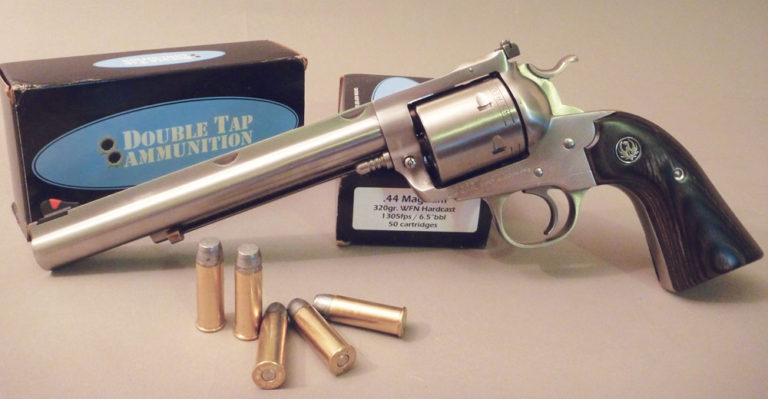

The .44 Magnum is one hard-hitting round, but there’s a time when serious handgun hunters turn toward more powerful calibers.
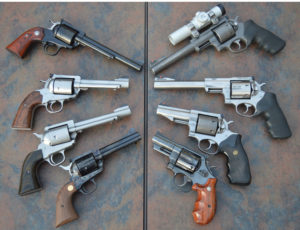 The .44 Magnum is a serious handgun round and the second revolver cartridge to bear the name “Magnum” on its head stamp. The .44 Remington Magnum made the scene in 1956, while Ruger and Smith & Wesson vied for the distinction of being the first to hit the market with the new high-powered cartridge with the introduction of the Ruger Super Blackhawk and the S&W Model 29. Smith & Wesson was first to market and, ironically, it was a little-known manufacturer, Great Western Arms Co., that also beat Ruger to market with a .44 Mag.
The .44 Magnum is a serious handgun round and the second revolver cartridge to bear the name “Magnum” on its head stamp. The .44 Remington Magnum made the scene in 1956, while Ruger and Smith & Wesson vied for the distinction of being the first to hit the market with the new high-powered cartridge with the introduction of the Ruger Super Blackhawk and the S&W Model 29. Smith & Wesson was first to market and, ironically, it was a little-known manufacturer, Great Western Arms Co., that also beat Ruger to market with a .44 Mag.
The .44s hit the shelves at gun shops nationwide, and the world hasn’t been the same since. But the big shot in the arm for the .44 Mag. from a standpoint of popularity was the 1971 film “Dirty Harry,” starring Clint Eastwood, the tough San Francisco detective who carried a Model 29 in a shoulder holster.
Actual diameter for the .44 Mag. is .429-inches, but it’s hard to imagine how popular a “.429 Magnum” would have been comparatively. This really is the quintessential big-bore round and what I consider a threshold cartridge, meaning that it is the upper limit for all but the most hardened handgunners and still needs to be approached with caution by true neophytes.
The .44 Mag. put handgun hunting on the map as a feasible endeavor, and it remained at the top position of power until 1983 when it fell victim to the game of one-upmanship with the release of Dick Casull’s wonder cartridge, the .454 Casull. It was a move the powers that be at Smith & Wesson never forgot—S&W returned the favor a couple of decades later when it released its .500 S&W Magnum. We are a consumer society after all, and it doesn’t take much to convince us we need something bigger, better, faster or more powerful.
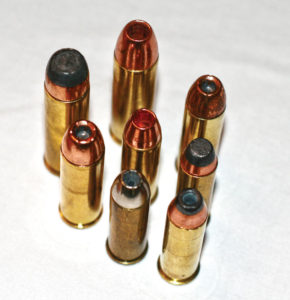
Still considered the classic big-bore revolver cartridge, the .44 Mag. to this day enjoys a strong following among big bore revolver lovers. There is no big-bore round that can claim the variety of available ammunition on the market with loads from mild to wild. If you do not reload, this is the cartridge for you; every possible load is available commercially, for virtually any and every application imaginable. The .44 Magnum is the gold standard by which all big revolver cartridges are measured.
So when do you actually need something bigger? The answer isn’t so simple, but I’ll say it anyway: never, actually. Before you proclaim me a blasphemer, let me qualify my statement with this: The .44 Rem. Mag., properly loaded (this caveat applies to any and every cartridge), can, will and has unequivocally taken virtually every game animal that walks the face of this planet. Here’s where I weasel my way out: In my experience, however, there are better choices for really large game, and they begin at .45 and go up from there. Will the .44 Mag. work on really big game? Yes. Are there better choices? Yes.
The .44 Mag. is a great deer cartridge, and while it will comfortably take much larger game, I prefer moving up in diameter when the game weight goes up. Bigger is better, as long as the shooter is capable of competently shooting the bigger calibers. With the move up comes a sizable increase in recoil. That said, the larger calibers do not need to be firewalled to be effective as a step up from the terminal performance offered by the .44 Mag. I can’t argue with larger diameter and heavier bullets.
Revolvers will never be able to boast the high velocity figures of even the mildest rifle cartridges, so they must rely on bullet diameter, weight and the nose profile of the bullet. For thin-skinned game I like expanding bullets, but at the subdued velocities of handguns, reliable expansion is elusive. And again, when starting out over .40 caliber, there really is no need for expansion.
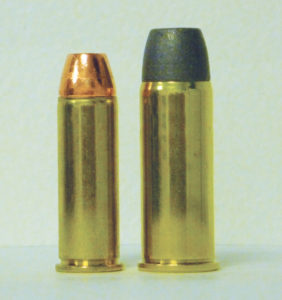
Instead, I prefer flat-nosed bullets (with a properly sized meplat) designed to penetrate deeply, particularly on larger game where penetration is your best friend. By default these bullets will make a large hole as they are starting out at a large diameter (relatively speaking). In my experience, two holes are better than one, since two holes tend to bleed more, so I really put a premium on penetration.
The first step north of the .44 Mag. is with the various .45 caliber rounds. The .45s come in a number of flavors, starting with the old warhorse and former black powder cartridge, the .45 Colt. Before you start thinking about the anemic cowboy action loads that are available for this chambering, consider that the .45 Colt in a decisively stronger Ruger revolver can be loaded considerably hotter. This isn’t your granddad’s .45. Most .45 Colt ammo that is available commercially is held to a SAAMI max pressure of 14,000 psi because there are many older revolvers (think Single Action Army) out there that cannot withstand much higher pressures.
Next up is the .454 Casull, a potent, 65,000 psi (SAAMI maximum pressure) brute of a round. The .460 S&W Mag. eclipses both of the lesser .45s with a full 1.8-inch case capable of pretty impressive velocities. The price paid for choosing the .460 is the platform necessarily big enough to house the big cartridge.
The .480 Ruger and its big brother, the .475 Linebaugh, are up next. The .475 Linebaugh, available in Magnum Research’s BFR revolver and Freedom Arms’ Model 83, is a serious cartridge for serious handgun hunters. Loaded to spec, the recoil is fierce, but the .475 is a very capable big-game getter. The smaller .480 Ruger (1.28-inch case length versus the .475’s 1.4-inch case) is the “Goldilocks cartridge” if there ever was one—just right. Loaded up, it will nip at the heals of the .475 Linebaugh, but it doesn’t need to be run that hard to work decisively on big game. It will throw heavy bullets at moderate velocities without beating the tar out of the shooter. The .480 is one of my favorites and has accounted for piles of game.
The half-inchers are next. These are very serious hunting cartridges. First up is the .500 JRH, the brainchild of gunsmith Jack Huntington (Jrhadvancedgunsmithing.com), essentially a cut-down .500 S&W (from 1.6 to 1.4 inches), offered in Magnum Research’s BFR (from their Precision Center). A ballistic twin to the .500 JRH is available from Freedom Arms called the .500 Wyoming Express (WE). The .500 Linebaugh (actual .511 diameter), while not available in a production revolver, enjoys quite a bit of popularity with handgun hunters and is a custom proposition only. Commercial ammunition is available from a number of sources.
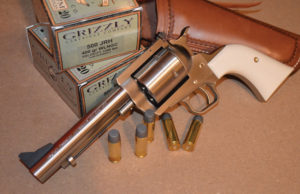
The big dog on the block is the .500 S&W Mag. Like its stable mate, the .460 S&W, the size necessitates a large platform to contain the big, raucous cartridge. All of these are capable of truly debilitating recoil if loaded up to spec. However, as I mentioned before, none of these cartridges needs to be loaded hot to offer a sizable increase in terminal performance over the .44 Mag.
If you are recoil sensitive, the .44 Mag. may be your limit, but the .45 Colt can be loaded to similar levels of recoil and makes a bigger hole. It is also capable of propelling heavier bullets than the .44. This is something to consider, but the .480 Ruger just might be the most logical choice in that it offers a considerable step up from the .44 Mag. terminally without earth-shattering recoil levels.
So when do you really need more than the .44 Mag? That is up to you and your abilities. You need to be honest with yourself and determine how much abuse you are willing and able to withstand. I know it may sound like I am sensationalizing recoil, but in all seriousness, very few people can shoot the .44 Mag. well.
These big revolvers require a lot of practice to master and are frankly not for everyone. If the .44 Mag. is your limit, there is no reason to fret. If you can handle it, and you intend to hunt large game, by all means step up. You will be well served. While the ubiquitous .44 Mag. is fully capable of most tasks asked of it, moving up in diameter is a good idea when elk, moose or pachyderm are on the menu. Ultimately, only you can determine if you really need more.
This article appeared in the June 2015 issue of Gun Digest the Magazine.

Next Step: Get your FREE Printable Target Pack
Enhance your shooting precision with our 62 MOA Targets, perfect for rifles and handguns. Crafted in collaboration with Storm Tactical for accuracy and versatility.
Subscribe to the Gun Digest email newsletter and get your downloadable target pack sent straight to your inbox. Stay updated with the latest firearms info in the industry.

![Best Concealed Carry Guns In 2025 [Field Tested] Wilson Combat EDC X9S 1](https://gundigest.com/wp-content/uploads/Wilson-Combat-EDC-X9S-1-324x160.jpg)


![Best 9mm Carbine: Affordable PCCs [Tested] Ruger Carbine Shooting](https://gundigest.com/wp-content/uploads/Ruger-Carbine-Shooting-100x70.jpg)
![Best AR-15: Top Options Available Today [Field Tested] Harrington and Richardson PSA XM177E2 feature](https://gundigest.com/wp-content/uploads/Harrington-and-Richardson-PSA-XM177E2-feature-100x70.jpg)

I’m needing longer grips for my 44 Mag six shooter Single action Western Marshall. When I shoot it..it bust my index finger against the trigger guard. The grips are to short.
The big bore S&W revolvers are awesome but just to darn heavy. I personally find the 44 mag with BB heavy Hardcastle adequate for anything I want to shoot with a hand gun. Give me a short rifle for anything bigger.
I think a important question is how far can you hit a 8″ circle with certainty? 44.mag and.45 Colt can take out any north American game out to 50 yards (maybe even further). I question whether the bigger cartridges really add value for the majority of handgun hunters.
You can go a long way with the .45 Colt in a Ruger. The 300 gr. Corbon loads readily available are about 30% more powerful that a .44magnum and all the current reloading manuals I’ve seen offer Ruger/TC loadings, some way beyond the Corbon loadings. I think the semi-exotic bigger bore offerings here are generally harder to find and more expensive to shoot. I would have thrown the .50 AE in there to round out the article also.